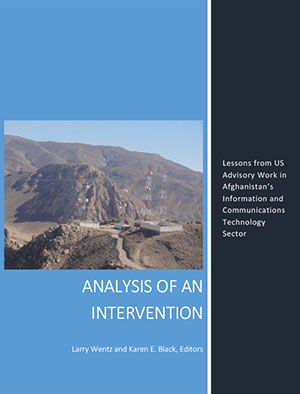DOWNLOAD: PDF | EPUB | MOBI
Foreword

After decades of war and civil strife, Afghanistan’s infrastructure had largely been destroyed and the
country had virtually no telecommunications services. Most Afghans had to travel to neighboring
countries to make phone calls, and data services were essentially non-existent. The ouster of the Taliban
at the hands of the US-led NATO Coalition in late 2001 ushered in a new era for Afghanistan. In 2002, the
Afghan Government laid the groundwork for the reconstruction of the country by adopting a policy
framework that encouraged public and private investment in Afghanistan’s rebirth. With the first private
company authorized to provide GSM telephone service in April of that year, the information and
communications technology (ICT) sector was among the very first post-war sectors to be established. To
date, the ICT has attracted over US$2 billion in private investment, is one of the largest contributors to
the Afghan treasury, and is one of Afghanistan’s greatest success stories.
Over the past 12 years, the ICT sector has experienced unprecedented and phenomenal growth: Six
companies provide mobile telephone service to nearly 22 million subscribers, and over 88 percent of
Afghans live in areas with cellular service. The price of SIM cards decreased from over US$250 in 2002 to
under a dollar today, and per-minute call costs have dropped by at least 95 percent and continue to
decrease. Five companies offer 3G mobile broadband services in 16 provinces and have achieved a
collective 400,000 customers since the introduction of 3G in March of 2012. We are expecting to introduce
4G services as well.
The first Internet service provider was licensed in 2004, and by 2013 over 50 licensed ISPs provided
Internet access to 2.4 million users. Internet prices fell from US$5,000 per Mbps per month in 2002 to
US$67/Mbps in February 2014. The volume of Internet traffic rose from under 250 gigabytes in 2004 to
4,850 gigabytes in 2012. Domestic Internet bandwidth nearly quadrupled from 557 Mbps in 2009 to 1,866
Mbps in 2011, while international bandwidth tripled from 3,175 Mbps to 9,891 Mbps during that same
time.
Afghanistan’s ambitious 5,000-kilometer national optical fiber ring is already connected to five of our
neighbors. As of mid-2014, over half (62 percent) of the fiber ring is operational, and metropolitan area
fiber networks are planned for six of Afghanistan’s principal cities. Afghanistan’s transition from analog to
digital broadcasting is well underway, with the May 11, 2014 inauguration of our first commercial satellite,
AfghanSAT1. Both endeavors came to fruition in 2014, a pivotal year in this chapter of Afghanistan’s
history.
It is widely recognized – but little documented – how ICT has underpinned and advanced progress in all
other areas in Afghanistan, including security, governance, socio-economic development, education,
agriculture, health, business, and women’s rights. We are on our way to transforming Afghanistan into an
Information Society. This book provides examples of how tremendously impactful ICT has been in
Afghanistan and how ICT has made differences – great and small – in the lives and livelihoods of every
Afghan. The book also underscores how fundamentally significant ICT is to a peaceful and prosperous
future for Afghanistan.
As you will see, the success of the Afghan ICT sector is a synergistic combination of many factors: forwardthinking
policy, legislation, and regulation; private investment; international assistance; the transparency
and accountability of, and execution by, Afghanistan’s public ICT institutions; and, not least of all,
overwhelming demand by Afghans eager to join the modern world. The US government’s Senior Telecom
Advisor and Telecommunications Advisory Team have been instrumental players in the attainment of our
accomplishments thus far. The people of Afghanistan and I are extremely grateful for their assistance in
working toward my vision of transforming Afghanistan into an information society.
Amirzai Sangin
Minister of Communications and Information Technology, 2004-2014
Kabul, Afghanistan
April 2014
READ FULL TEXT >>